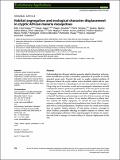Por favor, use este identificador para citar o enlazar a este item:
http://hdl.handle.net/10261/142003COMPARTIR / EXPORTAR:
 SHARE SHARE
 CORE
BASE CORE
BASE
|
|
| Visualizar otros formatos: MARC | Dublin Core | RDF | ORE | MODS | METS | DIDL | DATACITE | |

| Campo DC | Valor | Lengua/Idioma |
|---|---|---|
| dc.contributor.author | Tene Fossog, Billy | - |
| dc.contributor.author | Acevedo, Pelayo | - |
| dc.contributor.author | Besansky, Nora J. | - |
| dc.contributor.author | Costantini, Carlo | - |
| dc.date.accessioned | 2017-01-03T10:59:29Z | - |
| dc.date.available | 2017-01-03T10:59:29Z | - |
| dc.date.issued | 2015 | - |
| dc.identifier | doi: 10.1111/eva.12242 | - |
| dc.identifier | e-issn: 1752-4571 | - |
| dc.identifier | issn: 1752-4563 | - |
| dc.identifier.citation | Evolutionary Applications 8(4): 326-345 (2015) | - |
| dc.identifier.uri | http://hdl.handle.net/10261/142003 | - |
| dc.description | This is an open access article under the terms of the Creative Commons Attribution License.-- et al. | - |
| dc.description.abstract | Understanding how divergent selection generates adaptive phenotypic and population diversification provides a mechanistic explanation of speciation in recently separated species pairs. Towards this goal, we sought ecological gradients of divergence between the cryptic malaria vectors Anopheles coluzzii and An. gambiae and then looked for a physiological trait that may underlie such divergence. Using a large set of occurrence records and eco-geographic information, we built a distribution model to predict the predominance of the two species across their range of sympatry. Our model predicts two novel gradients along which the species segregate: distance from the coastline and altitude. Anopheles coluzzii showed a 'bimodal' distribution, predominating in xeric West African savannas and along the western coastal fringe of Africa. To test whether differences in salinity tolerance underlie this habitat segregation, we assessed the acute dose-mortality response to salinity of thirty-two larval populations from Central Africa. In agreement with its coastal predominance, Anopheles coluzzii was overall more tolerant than An. gambiae. Salinity tolerance of both species, however, converged in urban localities, presumably reflecting an adaptive response to osmotic stress from anthropogenic pollutants. When comparing degree of tolerance in conjunction with levels of syntopy, we found evidence of character displacement in this trait. | - |
| dc.description.sponsorship | Funding was provided by the Institut de Recherche pour le Dèveloppement, the National Institutes of Health (Projects R01 AI63508, and R01 AI76584 to NJB) and the Wellcome Trust (Intermediate Fellowship in Public Health and Tropical Medicine N° WT086423MA to CAN). PA was funded by the Spanish Ministerio de Economía y Competitividad (MINECO) and Universidad de Castilla-La Mancha (UCLM) through a ‘Ramón y Cajal’ contract(RYC-2012-11970). INAM was supported by a fellowship from the Universidad Nacional de Guinea Ecuatorial. | - |
| dc.publisher | Wiley-Blackwell | - |
| dc.relation.isversionof | Publisher's version | - |
| dc.rights | openAccess | - |
| dc.subject | Molecular forms | - |
| dc.subject | Malaria vector | - |
| dc.subject | Habitat segregation | - |
| dc.subject | Ecological speciation | - |
| dc.subject | Ecological character displacement | - |
| dc.subject | Cryptic species | - |
| dc.subject | Anopheles gambiae | - |
| dc.subject | Anopheles coluzzii | - |
| dc.subject | Niche partitioning | - |
| dc.subject | Urban pollution | - |
| dc.subject | Saltwater tolerance | - |
| dc.subject | Spatial ecology | - |
| dc.subject | Species distribution modelling | - |
| dc.title | Habitat segregation and ecological character displacement in cryptic African malaria mosquitoes | - |
| dc.type | artículo | - |
| dc.identifier.doi | 10.1111/eva.12242 | - |
| dc.relation.publisherversion | https://doi.org/10.1111/eva.12242 | - |
| dc.date.updated | 2017-01-03T10:59:29Z | - |
| dc.description.version | Peer Reviewed | - |
| dc.language.rfc3066 | eng | - |
| dc.rights.license | http://creativecommons.org/licenses/by/4.0/ | - |
| dc.contributor.funder | Institut de Recherche pour le Développement (France) | - |
| dc.contributor.funder | National Institutes of Health (US) | - |
| dc.contributor.funder | Wellcome Trust | - |
| dc.contributor.funder | Universidad de Castilla La Mancha | - |
| dc.contributor.funder | Universidad Nacional de Guinea Ecuatorial | - |
| dc.contributor.funder | Ministerio de Economía y Competitividad (España) | - |
| dc.relation.csic | Sí | - |
| dc.identifier.funder | http://dx.doi.org/10.13039/100000002 | es_ES |
| dc.identifier.funder | http://dx.doi.org/10.13039/100004440 | es_ES |
| dc.identifier.funder | http://dx.doi.org/10.13039/501100007480 | es_ES |
| dc.identifier.funder | http://dx.doi.org/10.13039/501100003329 | es_ES |
| dc.identifier.funder | http://dx.doi.org/10.13039/100012947 | es_ES |
| dc.identifier.pmid | 25926878 | - |
| dc.type.coar | http://purl.org/coar/resource_type/c_6501 | es_ES |
| item.fulltext | With Fulltext | - |
| item.openairecristype | http://purl.org/coar/resource_type/c_18cf | - |
| item.cerifentitytype | Publications | - |
| item.grantfulltext | open | - |
| item.openairetype | artículo | - |
| Aparece en las colecciones: | (IREC) Artículos | |
Ficheros en este ítem:
| Fichero | Descripción | Tamaño | Formato | |
|---|---|---|---|---|
| Africanmalariamosquito.pdf | 1,09 MB | Adobe PDF |  Visualizar/Abrir |
CORE Recommender
PubMed Central
Citations
50
checked on 30-mar-2024
SCOPUSTM
Citations
66
checked on 23-abr-2024
WEB OF SCIENCETM
Citations
54
checked on 29-feb-2024
Page view(s)
209
checked on 22-abr-2024
Download(s)
441
checked on 22-abr-2024

